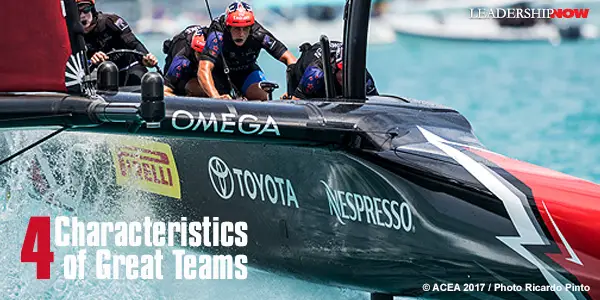 |
 |
06.28.17

4 Characteristics of Great Teams
T This year at the 35th America’s Cup in Bermuda, Team New Zealand beat the defending Oracle Team USA. What made their victory possible was a new team with a new approach. Great Teams Serve Each Other Team New Zealand operates as a team. Skipper Glenn Ashby said, “Everyone on this team is as important as the next guy. It’s a whole team policy where we have a belief in the collective power as a whole and not any one individual to get the job done.” A cyclor for New Zealand, Andy Maloney, added, "We pride ourselves on not everything being put into [skipper] Peter [Burling’s] or Glenn's hands. Whereas you see Jimmy Spithill and Tom Slingsby [of team Oracle] pretty much doing 99 percent of the work on the other boat.” When all members of the team serve each other through many small acts of service they balance out the whole team. Great Teams Maintain Their Composure and Focus Team New Zealand CEO Grant Dalton made an effort to stay behind the scenes. He also placed emphasis on the importance of the crew as a whole rather than individual team members. Team New Zealand believed they could win despite the odds and remain determined to do so despite the skeptics. Great Teams Overcome Adversity After their defeat four years ago, the New Zealand team was fractured and bitter. There was a lot of finger-pointing and some team members left. Skipper Glenn Ashby said, “It is very much a new team from 2013 across most departments and, as a result, we have a very healthy and fresh team culture.” They learned from 2013 and kept moving forward. They were able to tune out their critics. Great Teams Innovate Team New Zealand CEO Grant Dalton has said that the team almost folded due to lack of money. The board of directors came to the decision that they had no option but to shut the team down. Only a last minute influx of cash saved the team. But the lack of cash made them think and get creative with the resources they did have. They made a habit of doing things differently; operating at the margins. As a result, their innovations were a large part of their success. Specifically, they employed a revolutionary "cycling" system to power the hydraulics needed to control the catamaran's foils, which lift it out of the water, and the vast "wing" sail which drives it along. Great teams can set aside their limitations and innovate.
Posted by Michael McKinney at 12:15 AM
|
BUILD YOUR KNOWLEDGE
 

How to Do Your Start-Up Right STRAIGHT TALK FOR START-UPS 
Grow Your Leadership Skills NEW AND UPCOMING LEADERSHIP BOOKS 
Leadership Minute BITE-SIZE CONCEPTS YOU CAN CHEW ON 
Classic Leadership Books BOOKS TO READ BEFORE YOU LEAD |